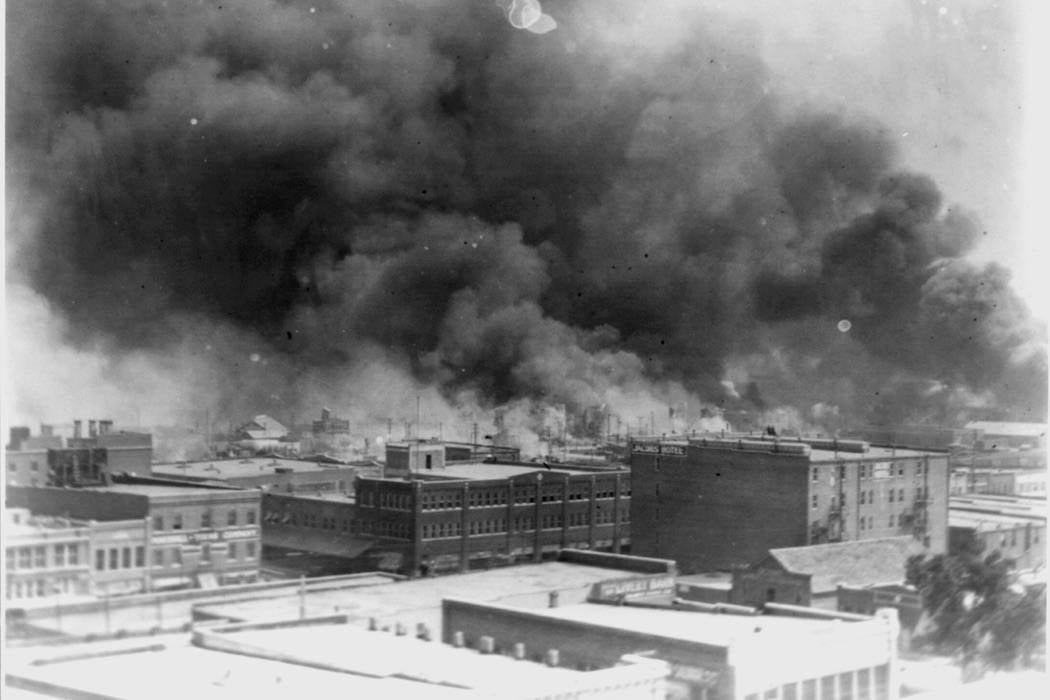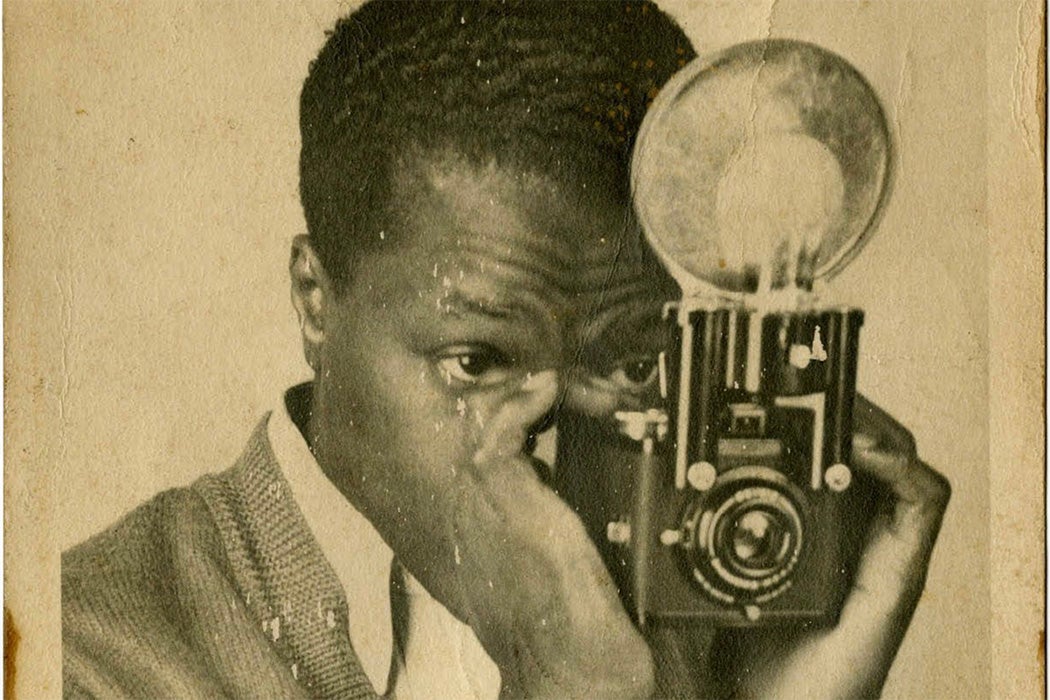In 1921, Tulsa, Oklahoma’s Greenwood District, known as Black Wall Street, was one of the most prosperous African-American communities in the United States. But on May 31 of that year, the Tulsa Tribune reported that a black man, Dick Rowland, attempted to rape a white woman, Sarah Page. Whites in the area refused to wait for the investigative process to play out, sparking two days of unprecedented racial violence. Thirty-five city blocks went up in flames, 300 people died, and 800 were injured. Defense of white female virtue was the expressed motivation for the collective racial violence.
Accounts vary on what happened between Page and Rowland in the elevator of the Drexel Building. Yet as a result of the Tulsa Tribune’s racially inflammatory report, black and white armed mobs arrived at the courthouse. Scuffles broke out, and shots were fired. Since the blacks were outnumbered, they headed back to Greenwood. But the enraged whites were not far behind, looting and burning businesses and homes along the way.
Nine thousand people became homeless, Josie Pickens writes in Ebony. This “modern, majestic, sophisticated, and unapologetically black” community boasted of “banks, hotels, cafés, clothiers, movie theaters, and contemporary homes.” Not to mention luxuries, such as “indoor plumbing and a remarkable school system that superiorly educated black children.” Undoubtedly, less fortunate white neighbors resented their upper-class lifestyle. As a result of a jealous desire “to put progressive, high-achieving African-Americans in their place,” a wave of domestic white terrorism caused black dispossession.
Weekly Newsletter
The creation of the powerful black community known as Black Wall Street was intentional. “In 1906, O.W. Gurley, a wealthy African-American from Arkansas, moved to Tulsa and purchased over 40 acres of land that he made sure was only sold to other African-Americans,” writes Christina Montford in the Atlanta Black Star. Gurley provided an opportunity for those migrating “from the harsh oppression of Mississippi.” The average income of black families in the area exceeded “what minimum wage is today.” As a result of segregation, a “dollar circulated 36 to 100 times” and remained in Greenwood “almost a year before leaving.” Even more impressive, at that time, the “state of Oklahoma had only two airports,” yet “six black families owned their own planes.”

These African-Americans’ economic status could not save them from the racial hostility of their day. Greenwood survivors recount disturbing details about what really happened that night. Eyewitnesses claim “the area was bombed with kerosene and/or nitroglycerin,” causing the inferno to rage more aggressively. Official accounts state that private planes “were on reconnaissance missions, they were surveying the area to see what happened.”
Despite all of the economic damage, Hannibal Johnson, author of Black Wall Street: From Riot to Renaissance in Tulsa’s Historic Greenwood District, explains that neither the survivors nor their families ever received the reparations suggested by the Tulsa Race Riot Commission. The commission recommended reparations for “people who lost property” and proposed “the establishment of a scholarship fund—that did happen, for a limited time.” The commission also proposed initiatives for the economic revitalization of the Greenwood community. Despite the tragic events, these grand ideas never manifested into a tangible reality.
Underlying Causes of the Massacre
In “The Tulsa Race Riot of 1921: Toward an Integrative Theory of Collective Violence,” the sociologist Chris M. Messer explores the underlying causes of the massacre. As a result of mass migrations to the area, driven in part by increased job opportunities, Tulsa became the city with the most African-Americans in the state. With a boom in the black population and their demands for equality, “perceptions of discrimination and shared experience among African-Americans…allowed for little time for adaptation among whites.” Tulsa’s rapid change in racial demographics made the city ripe for a riot motivated by white animosity against black economic progress. Whites of the era equated improvements in “wages and working conditions” as communistic threats. In essence, whites were resentful that blacks no longer passively accepted second-class citizenship in their own homeland.
Another structural factor that played a vital role in the Tulsa race riot was segregation. Ironically, black businesses benefited from self-sufficiency, which held both benefits and drawbacks for entrepreneurship. “Through maintenance of the legal separation of race in sociality, business, education, and residential areas, the structure of segregation encouraged initiative, but also placed parameters by restricting African-American opportunities,” Messer writes. In other words, since it was against the law for blacks to shop at white-owned stores, black businesses flourished. However, even though black businesses profited from how segregation reduced competition for black patrons, segregation also limited blacks’ mobility and opportunities to achieve outside their community.
According to Messer, the police force also contributed to the riot. Due to their ineffective leadership, they allowed mobs to gather at the courthouse for hours before seeking additional assistance. Furthermore, they actively participated in the riot by deputizing whites without discretion, arming them with guns to multiply the police force overnight. The police disregarded due process, arresting blacks and interning them in detention camps; meanwhile, no whites were arrested during the riot.
Both politicians and the media falsely framed the Tulsa riot as an uprising started by lawless blacks. Tulsa newspapers regularly referred to the Greenwood district as “Little Africa” and “n—–town.” African-Americans in the district were labeled “bad n—–s” who drank booze, took dope, and ran around with guns. Perhaps as a result of government officials’ stereotyping rhetoric and the media’s biased reporting, whites and blacks interpreted the racial violence differently. Generally, white politicians and residents perceived the black community “as predisposed to crime and in need of social control,” Messer explains. In other words, due to assumptions of black criminality, whites justified deadly violence on Black Wall Street, because blacks needed to be subjugated.
The Tulsa World newspaper inflamed the tensions between blacks and whites by suggesting that the Ku Klux Klan could “restore order in the community.” Since the KKK asserted white superiority with terroristic acts, such as lynchings, the mere suggestion from a mainstream newspaper that the KKK should intervene demonstrates how white supremacy was not only legitimized but also promoted with legal impunity. In the early 1900s, there was a rise in Black Nationalist organizations that refused to cower in the face of KKK violence or submit to societal subordination.
Whites responded to black pride and demands for equality with “social control, including segregation, lynchings, and pogroms,” Messer writes. In “Mass Media and Governmental Framing of Riots: The Case of Tulsa, 1921,” Messer and his colleague Patricia A. Bell offer further detail about how the media framed the riot, igniting tensions. In essence, blacks’ desire for socioeconomic progress and assertion of their rights was seen as a grave threat to white hegemony. Portraying all blacks as criminals served the black inferiority narrative, maintained Jim Crow segregation, and promoted the violent enforcement of racist ideology.
For instance, the racial framing of blacks as criminals legitimized whites’ congregation “at the courthouse and the subsequent destruction of the Greenwood area.” Consequently, it’s no surprise that blacks perceived the riot started by whites “as a massacre of their community.” The massacre of Black Wall Street primarily occurred due to whites “generalized perception that African-Americans were ‘out of line’” and needed to be put “back in their place.”
Despite racial discrimination and Jim Crow segregation, the Greenwood district offered proof that black entrepreneurs were capable of creating vast wealth. Based on critical analysis of the events, Messer asserts “there is evidence that whites perceived African-Americans as an economic threat to the city.” For those who supported black subjugation, witnessing blacks thrive and defy the stereotypes of black inferiority was too much.
Soon after the riot, Walter F. White of the National Association for the Advancement of Colored People (NAACP) visited Tulsa. According to him, black economic prosperity contributed to the destruction of the Greenwood District. White reported in The Nation how the city prospered under the oil boom. He stated that the town had grown from a population of 18,182 in 1910 to somewhere “between 90,000 to 100,000” residents by 1920. White claimed that the sudden wealth of the townspeople rivaled the “forty-niners” in California. However, when blacks experienced wealth, lower-class whites resented their success.
Many whites believed they were “members of a divinely ordered superior race.” Despite their inflated perceptions of themselves, there were three blacks in Oklahoma “worth a million dollars each.” A man named J.W. Thompson was worth $500,000. There were “a number of men and women worth $100,000; and many whose possessions” were “valued at $25,000 and $50,000 each. This was particularly true of Tulsa, where there were two colored men worth $150,000 each; two worth $100,000; three $50,000; and four who were assessed at $25,000.”
White concluded that many of the white pioneers in Oklahoma were former residents of “Mississippi, Georgia, Tennessee, [and] Texas.” Unfortunately, they failed to leave their “anti-Negro prejudices” behind in the Deep South. White had no positive words for Oklahoman whites. He considered them “[l]ethargic and unprogressive by nature, it sorely irks them to see Negroes making greater progress than they themselves are achieving.” In one instance, a white worker burned and demolished his black boss’s “printing plant with $25,000 worth of printing machinery in it.” In the process of leading the destructive mob, this disgruntled white employee was killed at the site.
The destruction of this successful African-American community was no accident. Messer asserts that “[t]he destruction of the community was rationalized as a necessary and natural response to put them back in their place.” Evidently, private industry and the state stood to benefit economically from the destruction. Two days after the riot, the mayor wasted no time in establishing the Reconstruction Committee to redesign the Greenwood District for industrial purposes. Blacks were offered below market value for their property. White men who offered “almost any price for their property” perceived survivors as desperate and destitute.
More to Explore
Seeking Clues in Cabinet Cards
In essence, African-Americans posed a “geographical problem because their community was situated in an ideal location for business expansion.” The government and private industry worked in concert to bring down land prices and maintain white dominance in the Tulsa area. Poor whites’ resentment of successful, landowning blacks allowed elite whites to use them as pawns to obtain more land, wealth, and prosperity. Judging by the legal impunity granted to whites by law enforcement, the state endorsed and, in fact, supported the Tulsa riot for self-serving, capitalistic gains.
Historically, American capitalism has thrived with an elite few maintaining power and wealth. When blacks gain a strong foothold in a community or industry, they have the power to effect meaningful change. Thus, the socioeconomic progress of African-Americans on Black Wall Street threatened the power structure of white-dominated American capitalism. When white people destroyed black business establishments and homes, the façade of white superiority was maintained.
By the 1940s, the Greenwood District was rebuilt, but due to integration during the Civil Rights era, never regained as much prominence. The fate of Black Wall Street illustrates that as long as power remains in the hands of elite, mainly white families, America’s socioeconomic system can be marshalled to support and advance the tenets of white supremacy. Regardless of the progress made by prominent African-Americans, American capitalism is structured to keep a white segment of society ahead of the remaining marginalized many.
Support JSTOR Daily! Join our new membership program on Patreon today.








